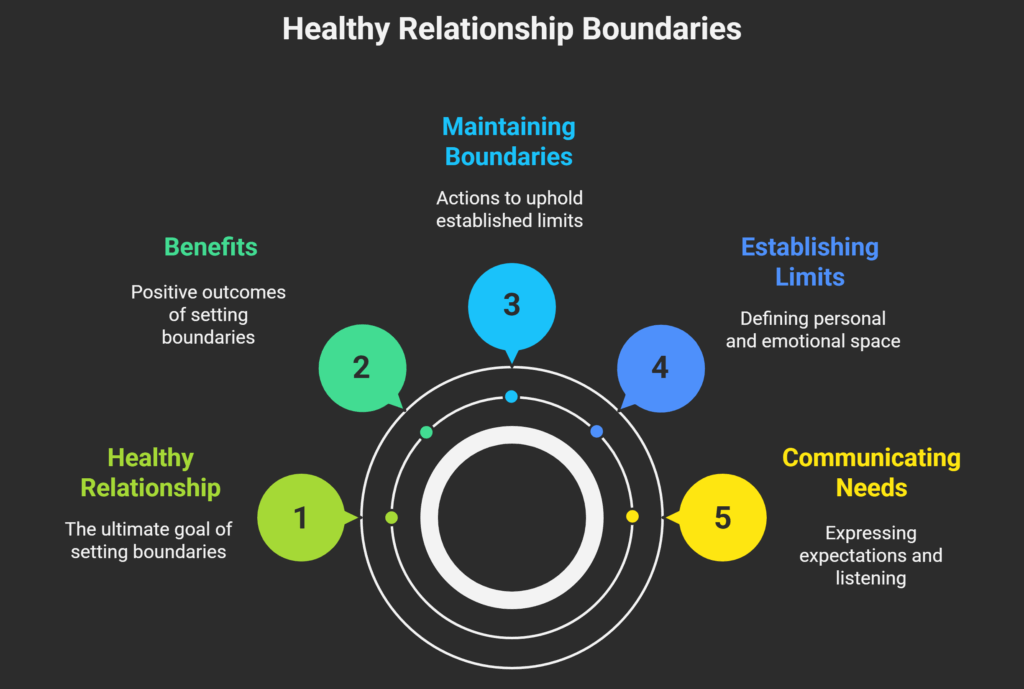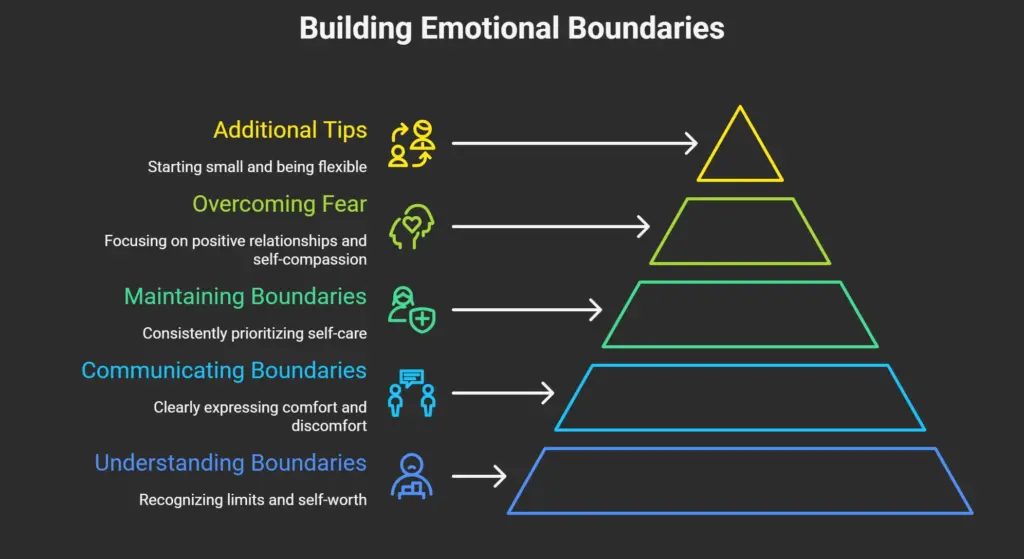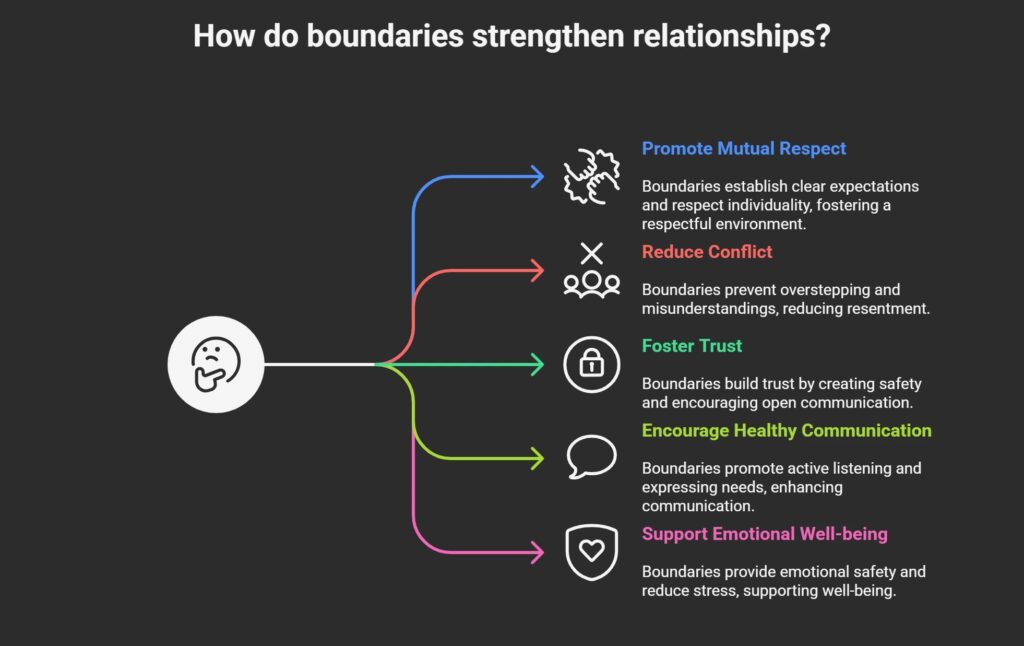
Healthy boundaries in relationships are essential if you want to build a strong and lasting connection. Setting clear boundaries helps both partners feel safe, respected, and emotionally supported from the very beginning.
Setting boundaries is key! By understanding your partner’s needs, desires, and aspirations, you can create a foundation for mutual respect and trust. Boundaries help you distinguish between your individual needs and shared goals, allowing you to work together towards a fulfilling relationship. Don’t underestimate the power of healthy boundaries – they’re a game-changer for any successful relationship!
Setting boundaries in a relationship is essential to maintain your emotional, physical, and mental well-being.
Let’s consider an example:
Sarah and Alex have been dating for a few months. Sarah values her alone time and needs space to recharge. However, Alex often calls or texts her multiple times a day, expecting immediate responses.
Without Boundaries:
Sarah starts feeling suffocated, anxious, and resentful. She might feel pressured to constantly respond, compromising her own needs.
With Boundaries:
Sarah communicates her boundaries clearly: “Hey Alex, I love talking to you, but I need some space. Can we schedule specific times to talk each day? I’d appreciate it if you didn’t call/text me multiple times a day.”
Benefits:
By setting boundaries, Sarah:
- Communicates her needs and expectations.
- Maintains her personal space and autonomy.
- Reduces feelings of anxiety and resentment.
- Strengthens the relationship by establishing mutual understanding.
Learn More About Boundary Setting? Read on to discover more about boundary setting and how it can make your relationships healthier…
How to set boundaries with your partners

Rebuilding Trust
- Acknowledge the hurt: Taylor acknowledges the hurt they caused and takes responsibility for their actions.
- Open conversation: You have an open and honest conversation about what happened and how to prevent it in the future.
- New boundaries: You establish new boundaries and expectations for communication and intimacy.
Consistent Actions
- Follow-through: Taylor consistently follows through on their commitments and respects the new boundaries.
- Transparency: Taylor is transparent about their actions and communication, helping to rebuild trust.
Healing and Growth
- Emotional healing: You both work on emotional healing and growth, addressing underlying issues.
- Rebuilding intimacy: You gradually rebuild intimacy and trust through consistent effort and communication.
Outcome
- Renewed trust: Trust is rebuilt over time through consistent actions and open communication.
- Stronger relationship: Your relationship becomes stronger and more resilient as you both work together to maintain boundaries and trust.
Setting boundaries with your partner can be challenging, but clear communication and mutual respect are key. Here are some steps to consider:
Discuss Boundaries with Your Partner
- Communicate openly with your partner about your feelings and concerns.
- Establish mutual understanding and agreement on boundaries.
- Ensure both partners are on the same page regarding boundaries.
Define Boundaries
- Limit contact or communication if necessary.
- Determine limits for meetings and interactions.
- Establish expectations for respectful behavior.
- Avoid intimate conversations or sensitive topics.
Set Clear Expectations
- Establish a clear communication channel.
- Define when and how communication should occur.
- Focus on co-parenting responsibilities if applicable.
Prioritize Your Relationship
- Focus on nurturing your relationship with your partner.
- Address concerns and insecurities openly.
- Strengthen your bond and build trust.
Be Flexible
- Be open to adjusting boundaries as circumstances change.
- Communicate changes with your partner.
- Be willing to adapt and reassess boundaries.
Seek Support
- Recognize when you need help navigating boundaries.
- Consider couples counseling or online relationship counseling.
- Seek professional help to establish healthy boundaries and manage stress.
By being flexible and seeking support when needed, you can effectively manage boundaries and maintain a healthy relationship.
Setting healthy relationship boundaries

Setting healthy relationship boundaries involves:
Communicating Needs
- Expressing expectations: Clearly state what you are and aren’t comfortable with.
- Active listening: Hear and respect your partner’s needs and boundaries.
Establishing Limits
- Physical boundaries: Define personal space and physical affection.
- Emotional boundaries: Set limits on emotional labor and support.
- Digital boundaries: Establish social media, messaging, and online interactions guidelines. If you are facing any kind of problems while setting the boundaries then Setting relationship boundaries with OPPAM
Prioritizing Self
- Self-care: Make time for activities that nourish your mind, body, and soul.
- Assertiveness: Speak up when your boundaries are crossed.
Maintaining Boundaries
- Consistency: Enforce boundaries consistently.
- Respect: Treat each other’s boundaries with respect.
- Flexibility: Be open to adjusting boundaries as needed.
Benefits
- Increased trust: Boundaries foster trust and respect.
- Improved communication: Clear boundaries promote healthy communication.
- Healthier relationship: Boundaries help prevent conflicts and resentment.
Seek professional help
- Consider couples’ counseling or relationship counseling, Online therapy for relationship trust issues, Couples counseling for setting boundaries,
- OPPAM relationship counseling online, Online therapy for relationship insecurities at OPPAM will be the best option for you.
By setting healthy boundaries, you can build a stronger, more respectful relationship.
How to Communicate Your Needs in a Relationship
You’re in a relationship with Jamie, and you feel like you’re not getting enough quality time together.
Communicating Needs
- Identify your needs: You recognize that you need more quality time with Jamie.
- Choose the right time: You find a good time to talk to Jamie when you’re both relaxed.
- Use “I” statements: You express your feelings using “I” statements, saying, “I feel loved and connected when we spend quality time together. Can we schedule regular date nights?”
Active Listening
- Jamie listens: Jamie listens attentively to your concerns and responds empathetically.
- Understanding: Jamie understands your needs and is willing to make changes.
Finding a Solution
- Collaborative problem-solving: You both work together to find a solution, such as scheduling regular date nights.
- Compromise: You find a compromise that works for both of you.
Outcome
- Improved communication: Your communication improves, and you feel heard.
- Stronger relationship: Your relationship strengthens as you both work together to meet each other’s needs.
Communicating your needs in a relationship involves:
Expressing Needs
- Communicate clearly and directly with your partner.
- Use “I” statements to express feelings and needs.
- Avoid blaming your partner; instead, focus on your own needs
Active Listening
- Create a mindset to listen to your partner.
- Pay attention to your partner’s needs and concerns.
- Empathize with your partner’s feelings.
- Validate your partner’s emotions to show understanding.
Finding Solutions
- Collaborate to find mutually beneficial solutions.
- Work together to resolve issues.
- Be open to compromise and finding a middle ground.
Maintaining Open Communication
- Prioritize effective communication in your relationship.
- Schedule regular conversations to discuss needs and concerns.
- Seek feedback from your partner and respond thoughtfully.
- Engage with feedback to facilitate growth and change.
Key Considerations
- Communicate needs respectfully, avoiding blame.
- Foster a willingness to adapt to changing needs.
Seek Support
- Consider seeking mental health support if communication is challenging.
- Relationship counseling or couple’s therapy can be beneficial.
- Online therapy options are available for specific relationship issues.Consider OPPAM relationship counseling online, Setting relationship boundaries with OPPAM, Online therapy for relationship insecurities at OPPAM, and Book a therapist at OPPAM for relationship support
Setting emotional boundaries without fear

1.Understanding your boundaries
- To set emotional boundaries, it’s essential to have a clear understanding of your own boundaries.
- Recognizing your limits and what makes you comfortable or uncomfortable is crucial.
- Additionally, acknowledging your worth and deservingness of respect and kindness is vital. Sometimes, we forget to recognize our value, so it’s essential to acknowledge and appreciate ourselves.
2.Communicating Boundaries
- Communicating your boundaries clearly and assertively with your partner is crucial. When discussing boundaries, it’s essential to be clear and direct.
- Using “I” statements to express your feelings can be helpful, allowing you to discuss your boundaries without blaming your partner.
- It’s also important to set specific boundaries, clearly defining what you’re comfortable with and what you’re not, and discussing this with your partner.
3.Maintaining Boundaries
- Setting boundaries is not enough; maintaining them consistently is crucial.
- Prioritize self-care and engage in activities that positively impact your physical, mental, and emotional well-being, which in turn benefits your relationship.
- If you’re struggling to set emotional boundaries or feeling pressured to discuss them with your partner, consider seeking professional help, such as therapy for boundary setting in couples or online counseling for relationship boundaries.
4.Overcoming Fear
- By focusing on positive relationships and environments, you can better maintain your emotional boundaries and overcome fear.
- Practicing self-compassion is crucial. Treating yourself with kindness and understanding can help build self-confidence and self-trust.
- Developing self-confidence and surrounding yourself with healthy relationships and people who respect your boundaries is also essential.
5.Additional Tips
- Start with small boundaries and gradually work your way up. This approach helps you understand your needs and allows partners to reach a mutual understanding.
- When communicating boundaries, be assertive but not aggressive. Be open to feedback and willing to adjust your boundaries as needed.
- Consider others’ circumstances and be flexible when necessary. Maintaining an open mindset can be beneficial in these situations.
How boundaries build stronger relationship

Boundaries can build stronger relationships in several ways:
Promoting Mutual Respect
- Clear expectations: Boundaries help establish clear expectations and guidelines for behavior.
- Respect for individuality: Boundaries respect each person’s individuality and personal space.
Reducing Conflict
- Preventing overstepping: Boundaries prevent overstepping and misunderstandings.
- Reducing resentment: Boundaries help reduce resentment and frustration.
Fostering Trust
- Building trust: Boundaries help build trust by establishing a sense of safety and predictability.
- Encouraging open communication: Boundaries encourage open and honest communication.
Encouraging Healthy Communication
- Building trust: Boundaries help build trust by establishing a sense of safety and predictability.
- Encouraging open communication: Boundaries encourage open and honest communication.
Supporting Emotional Well-being
- Emotional safety: Boundaries provide emotional safety and protection.
- Reducing stress: Boundaries help reduce stress and anxiety.
Setting boundaries can help make relationships healthier. If you’re struggling to set boundaries or feeling pressured, don’t worry. Oppam’s expert therapists are here to support you in this process. Develop healthy relationship habits with Oppam.




